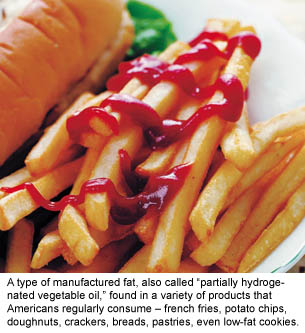Trans Fats: What’s the Big Deal, Anyway?
Trans Fats: What’s the Big Deal, Anyway?

Efforts to eliminate or reduce trans fats in Americans’ diets have made headlines in recent months. Among the big newsmakers: New York City, where officials banned trans fats in restaurants, and companies such as Starbucks that have taken steps to eliminate it from many of their foods. Closer to home, Kentucky-based YUM! Brands’ KFC and Taco Bell said they are switching to a zero gram trans fat cooking oil.
So what’s the story behind these headline-grabbers? A type of manufactured fat, also called “partially hydrogenated vegetable oil,” found in a variety of products that Americans regularly consume – french fries, potato chips, doughnuts, crackers, breads, pastries, even low-fat cookies.
“Fast foods, fried foods and a lot of processed foods have this hydrogenated fat in them,” said Sandra Bastin, food and nutrition specialist with the UK Cooperative Extension Service, who considers the trend to reduce any fat in the diet good news.
“In my opinion, we all eat too much fat anyway,” she said. “If we would stay within that recommended 30 percent of our dietary calories from fat, we probably would avoid even having to talk about trans fat.”
But people are talking about trans fat. Trans-fatty acids, commonly known as trans fats, occur naturally in small amounts in meat and dairy products. But since the 1900s, manufacturers have been processing naturally occurring unsaturated fats into trans fats so that they are solid at room temperature and, therefore, help products stay fresh longer. Trans fats also produce a different “mouth feel,” Bastin said. “There’s a different texture and a different flavor.”
The problem with trans fat occurs in the processing, which involves adding hydrogen to liquid vegetable oil or other natural fat. The result is an unhealthy saturated fat. Trans fat is thought to boost “bad” cholesterol and decrease “good” cholesterol and has been linked to an increased risk of heart disease, obesity and childhood asthma.
”Most of the fat that we eat too much of comes from fast foods and fried foods, which are often made with hydrogenated fat. Then we eat a lot of processed foods because we’re not cooking as much at home anymore,” said Bastin, citing a U.S. Food and Drug Administration statistic that shows the average adult consumes 5.8 grams of trans fat daily – or 26 percent of his calories.
“It’s something we have to think about,” she added.
Bastin and Extension professionals throughout the state encourage people to read the Nutrition Facts labels on food packaging to see how much trans fat a food item contains. Since 2006, food manufacturers are mandated to list the trans fat content separately on those labels.
“I look at this as an opportunity for people to start looking at the labels and seeing that, ‘Oh my goodness, all my favorite baked goods or all my favorite frozen dinners or all my favorite boxed meals … are high in trans fats. Maybe I ought to rethink how often I’ve been having them,’“ Bastin said.
But she cautions people not to be misled by packaging that says, “trans fat free.”
“Just because they replace the trans fat, there’s still the same amount of fat in there, which means there’s the same amount of calories from fat in that product,” Bastin said.
She also reminds people that watching the amount of fat they consume is only part of the effort to live a healthier lifestyle.
“You can watch your trans fats all day, but the bottom line is still the same: You’ve got to have a varied diet, eat in moderation and get exercise,” she said.
